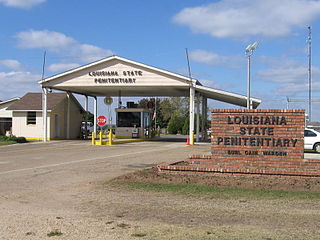Related Research Articles

Capital punishment is a legal penalty in the U.S. state of Louisiana.
Capital punishment is a legal penalty in the U.S. state of Arkansas.

Capital punishment is a legal penalty in the U.S. state of Ohio, although all executions have been suspended indefinitely by Governor Mike DeWine until a replacement for lethal injection is chosen by the Ohio General Assembly. The last execution in the state was in July 2018, when Robert J. Van Hook was executed via lethal injection for murder.
Capital punishment is a legal penalty in the U.S. state of Utah.

Capital punishment was abolished via the legislative process on May 2, 2013, in the U.S. state of Maryland.
Capital punishment is a legal penalty in the U.S. state of Nebraska. In 2015, the state legislature voted to repeal the death penalty, overriding governor Pete Ricketts' veto. However, a petition drive secured enough signatures to suspend the repeal until a public vote. In the November 2016 general election, voters rejected the repeal measure, preserving capital punishment in the state. Nebraska currently has 12 inmates on death row.
Capital punishment is a legal penalty in the U.S. state of Oklahoma.
George Sidney Sitts was a convicted murderer who was executed by South Dakota for killing state Division of Criminal Investigation special agent Tom Matthews, who was attempting to arrest Sitts on a fugitive warrant from Minnesota.
Capital punishment in Connecticut formerly existed as an available sanction for a criminal defendant upon conviction for the commission of a capital offense. Since the 1976 United States Supreme Court decision in Gregg v. Georgia until Connecticut repealed capital punishment in 2012, Connecticut had only executed one person, Michael Bruce Ross in 2005. Initially, the 2012 law allowed executions to proceed for those still on death row and convicted under the previous law, but on August 13, 2015, the Connecticut Supreme Court ruled that applying the death penalty only for past cases was unconstitutional.
Capital punishment is a legal penalty in the U.S. state of Wyoming.
Capital punishment was abolished in Colorado in 2020. It was legal from 1974 until 2020 prior to it being abolished in all future cases.

Capital punishment is a legal penalty in the U.S. state of Florida.

Capital punishment is a legal penalty in the U.S. state of Mississippi.
Capital punishment is a legal penalty in the U.S. state of North Carolina.
Capital punishment is currently a legal penalty in the U.S. state of Kansas, although it has not been used since 1965.
Capital punishment is a legal penalty in the U.S. state of Georgia. Georgia reintroduced the death penalty in 1973 after Furman v. Georgia ruled all states' death penalty statutes unconstitutional. The first execution to take place afterwards occurred in 1983.
Capital punishment in Delaware was abolished after being declared unconstitutional by the Delaware Supreme Court on August 2, 2016. The ruling retroactively applies to earlier death sentences, and remaining Delaware death row inmates had their sentences commuted to life imprisonment. Despite this, the capital statute for first-degree murder under Title 11, Chapter 42, Section 09, of the Delaware Code has yet to be repealed, though it is unenforceable.
Capital punishment is a legal punishment in Tennessee.
Capital punishment in Missouri first used in 1810 is a legal penalty in the U.S. state of Missouri.
Capital punishment is a legal punishment in Pennsylvania. Despite remaining a legal penalty, there have been no executions in Pennsylvania since 1999, and only three since 1976. In February 2015, Governor Tom Wolf announced a formal moratorium on executions that is still in effect as of 2023, with incumbent Governor Josh Shapiro continuing Wolf's moratorium. However, capital crimes are still prosecuted and death warrants are still issued.
References
- ↑ "Archived copy". Archived from the original on 2008-04-21. Retrieved 2008-04-19.
{{cite web}}: CS1 maint: archived copy as title (link) - ↑ "23A-27A-4. Aggravating circumstance and recommendation of death penalty required for Class A felony death sentencing--Life imprisonment--Bench trial or guilty plea". sdlegislature.gov. Retrieved April 16, 2017.
- ↑ "§ 3. Powers and duties of the Governor". sdlegislature.gov. Retrieved April 16, 2017.
- ↑ "Frequently Asked Questions: Capital Punishment:: SD Dept. Of Corrections". Archived from the original on 2015-02-26. Retrieved 2015-03-17.
- ↑ "Methods of Execution | Death Penalty Information Center". Deathpenaltyinfo.org. Archived from the original on 2008-07-03. Retrieved 2016-07-21.
- ↑ South Dakota Codified Laws § 23A-27A-1
- 1 2 "Regional Studies Central". Archived from the original on 2008-10-17. Retrieved 2008-05-05.
- ↑ "Archived copy". Archived from the original on 2008-02-23. Retrieved 2008-04-19.
{{cite web}}: CS1 maint: archived copy as title (link) - 1 2 "South Dakota DOC-FAQ-Capital Punishment". Archived from the original on 2008-04-07. Retrieved 2008-04-19.
- ↑ "Appeal for Electric Chair Refused by WPB". The Daily Illini . July 10, 1942. Retrieved October 29, 2020.
- ↑ "Vermont Electric Chair Can't Be Used By South Dakota”, Burlington Vermont Free Press, 1942, July 14, pp. 2–2.
- ↑ “Electric Chair Is Here - Illinois Men Set It Up", Sioux City Argus-Leader, 1942, August 5, pp. 1-1.
- ↑ "State Obtains Equipment for Electric Chair", Sioux Falls Argus-Leader, 1944, February 9, pp. 18-18
- ↑ “Sitts May Be First to Die in Electric Chair in State”, Sioux Falls Argus-Leader, 1946, March 22, pp. 1-1.
- ↑ “Unmarked Grave Will Hold Remains of Three-Time Killer George Sitts”, Rapid City Journal, 1947, April 8, pp. 1–1.
- ↑ "Americas Electric Chairs". Archived from the original on 2008-05-14. Retrieved 2008-05-14.
- ↑ "Archived copy". Archived from the original on 2015-05-23. Retrieved 2015-06-15.
{{cite web}}: CS1 maint: archived copy as title (link) - ↑ "A history of capital punishment in South Dakota". Associated Press . November 14, 2019.